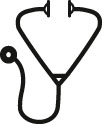Abstract

Introduction The American Society of Hematology (ASH) Choosing Wisely campaign have created thoughtful conversations between providers and patients in recommending care that is supported by evidence to reduce duplicative testing. However, some have raised concerns regarding the impact on patient care. We provide our institutional experience in exploring the clinical feasibility of the recommendation on reducing unnecessary inpatient thrombophilia testing.
Methods This was a retrospective review of patients admitted with a diagnosis of venous thromboembolism (VTE) across the 3 hospitals in Central PA from September 2021 to December 2021. Pregnancy was an exclusion criterion. Thrombophilia workup included tests for factor V Leiden mutation, activated protein C resistance, protein S activity, antithrombin deficiency, prothrombin gene mutation, anti-cardiolipin antibodies, dilute Russell viper venom time, lupus anticoagulant, anti-beta2-glycoprotein antibodies. The cost of testing was extrapolated by institutional hospital cost reports. Descriptive statistics included reporting the categorical variables as number and percent. The categorical variables were compared between groups with the use of Fisher's exact test or the chi-square test.
Results During our study period, 310 patients had new VTE. Of those, 47.9% had pulmonary embolism, 33.7% upper or lower extremities deep vein thrombosis (DVT), 1.6% splanchnic DVT, 14.6% multiple DVTs, and 2.2% DVTs in other locations. The median age was 64. Provoked factors were found in 269 patients (86.7%) and 41 patients (13.2%) had unprovoked VTE. Overall, 33 out of 310 patients (10%) underwent thrombophilia workup with a total of 175 tests performed. More thrombophilia testing was ordered in unprovoked group (29.3% vs 7.8%, p=0.0003) compared to provoked. There was no difference between the amount of inpatient hematology consults in both groups (33.83% vs 47.50%, p=0.0920). Of the hematology consult, 19 out of 118 patients (16%) had thrombophilia testing recommended by hematologist. The cost of all tests ordered outside of hematology recommendation was $34,083 (avg $344 per person). Of the group that got tested regardless of provoking factors, there was no difference between hospital length of stay (2-12 days vs 3-12 days, p= 0.0665). Anticoagulation choice was also not affected by thrombophilia testing between the two groups.
Discussion Our experience found that many thrombophilia work up were costly and did not impact quality patient care. Despite the relatively low frequency of inpatient workup (10%), eliminating testing could save our health system approximately $136,332 per year ($34,083 per quarter). Therefore, we support ASH's campaign in reducing inpatient thrombophilia testing. We aim to work with our administration to provide education in reducing unnecessary testing as a part of a quality improvement initiative.
Disclosures
Lu:DSI/AstraZeneca: Speakers Bureau; Gilead: Speakers Bureau; Seagen: Speakers Bureau.
Author notes
 This icon denotes a clinically relevant abstract
This icon denotes a clinically relevant abstract
Asterisk with author names denotes non-ASH members.

This feature is available to Subscribers Only
Sign In or Create an Account Close Modal